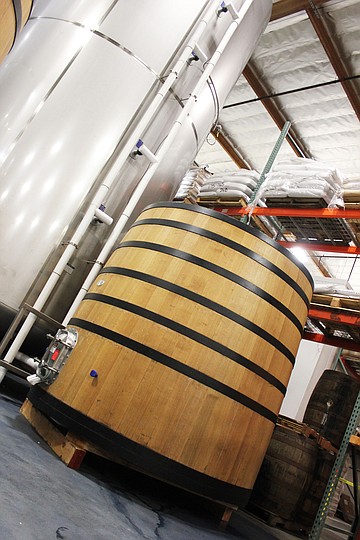 Facebook
Facebook
 X
X
 Instagram
Instagram
 TikTok
TikTok
 Youtube
Youtube

You know you’re way into beer when you’re seated in a brewery, enjoying course after course of thoughtful food paired with fine craft beer, and instead of keeping your head down and focusing on consumption, you break away from a rare rye barleywine to stare at wooden storage receptacles. To find the vessels that houses beer as riveting or more intriguing than the act of drinking beer itself epitomizes what it means to be truly afflicted by brew bug.
The above referenced incident took place during a feast in the tasting room at Green Flash Brewing Company. We were four courses in when I turned around to look at the nearby cellar and spotted something that hadn’t been there the last time I was in—a quartet of what look like giant wooden half-barrels. They’re called foudres and are common in the wine industry. Green Flash procured theirs from a Northern California winery that had used them for red wine blending, storage and aging.

Brewmaster Chuck Silva says his intention is to use the foudres to extend Green Flash’s barrel-aging program. Two of the vessels will be used for mass inoculation of Brettanomyces (a wine industry scourge) and increased production of the company’s wild yeast beers, Little Freak and Super Freak. The other two foudres have a date with some Lactobacillus, a culture used to produce sour beers, most notably the fruity, acidic Flanders Drive Flanders-style red ale released earlier this year.
Each foudre can hold 50 barrels of beer, and the aforementioned beers will each take anywhere from six to 18 months to mature to their optimal finished state. But that’s not the only wood Green Flash is packing. They’ve also upped the already impressive number of liquor-laced oak barrels they’re using to age other long-lead fan favorites including Bourbon barrel-aged Silva Stout and Sleepin’ with Shaggy brandy barrel-aged barleywine.
And now that that’s all sorted out, I’m going back to drinking (and suggest you do the same).


You know you’re way into beer when you’re seated in a brewery, enjoying course after course of thoughtful food paired with fine craft beer, and instead of keeping your head down and focusing on consumption, you break away from a rare rye barleywine to stare at wooden storage receptacles. To find the vessels that houses beer as riveting or more intriguing than the act of drinking beer itself epitomizes what it means to be truly afflicted by brew bug.
The above referenced incident took place during a feast in the tasting room at Green Flash Brewing Company. We were four courses in when I turned around to look at the nearby cellar and spotted something that hadn’t been there the last time I was in—a quartet of what look like giant wooden half-barrels. They’re called foudres and are common in the wine industry. Green Flash procured theirs from a Northern California winery that had used them for red wine blending, storage and aging.

Brewmaster Chuck Silva says his intention is to use the foudres to extend Green Flash’s barrel-aging program. Two of the vessels will be used for mass inoculation of Brettanomyces (a wine industry scourge) and increased production of the company’s wild yeast beers, Little Freak and Super Freak. The other two foudres have a date with some Lactobacillus, a culture used to produce sour beers, most notably the fruity, acidic Flanders Drive Flanders-style red ale released earlier this year.
Each foudre can hold 50 barrels of beer, and the aforementioned beers will each take anywhere from six to 18 months to mature to their optimal finished state. But that’s not the only wood Green Flash is packing. They’ve also upped the already impressive number of liquor-laced oak barrels they’re using to age other long-lead fan favorites including Bourbon barrel-aged Silva Stout and Sleepin’ with Shaggy brandy barrel-aged barleywine.
And now that that’s all sorted out, I’m going back to drinking (and suggest you do the same).
Comments